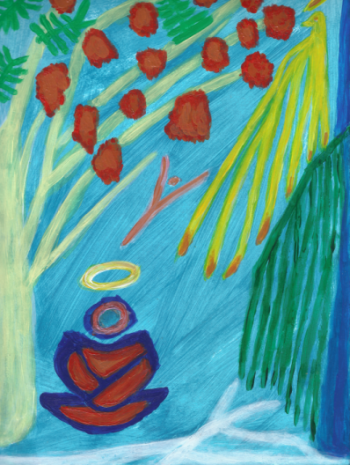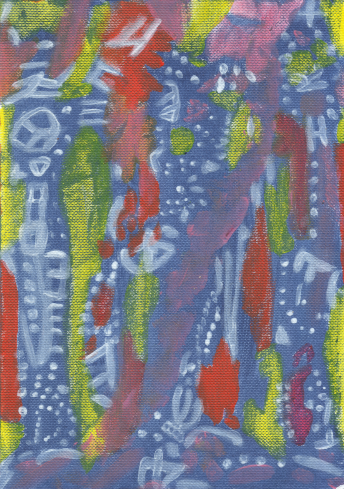MIndfulness of dhamma categories
This is the fourth foundation of mindfulness. There are five categories here to be mindful of: the five hindrances; the five aggregates of clinging; the six external and six internal sense bases; the seven factors of awakening; and the four noble truths.
What follows is my current understanding of the fourth foundation of mindfulness:
The five hindrances
These are: greed, aversion, stagnation, restlessness, and doubt.
They are called hindrances, because they are what stop us from reaching the deep states of meditation and prevent us from seeing things clearly, they distort our perception of reality.
Greed/lust is like being in debt, one feels a sense of lack and does not feel happy until one gets what one wants, this longing, this wishing is unpleasant and creates a feeling of disatisfaction and dis -ease in the mind. Like when coloured dye is added to water, the water looks attractive but it distorts things and makes them unclear.
Aversion is like being afflicted by a sickness. Anger/hatred is painful, it literally poisons the body with harmful toxins, like a burning coal that one picks up and throws, which burns oneself as well as where it is thrown. It is like boiling water that distorts the surface so one cannot see clearly.
Stagnation is like being in prison. One feels stuck and unable to escape the dullness and drowsiness, the fatigue. Like a stagnant pond with slime and algae growing over the surface, one cannot see the water clearly.
Restlessness is like being a slave to a control freak of a boss, who never leaves you alone, is always making demands on your time and pushing you. It is like the wind blowing ripples and waves across the surface of water making it difficult to see it clearly.
Doubt is like being at a crossroads and not knowing which way to go. If the wrong choice is made it could be disastrous. One cannot stay choosing for long as that is also dangerous because their are bandits about. So one has to make a choice and hope they pick the right direction. Doubt is like muddy water, where one cannot see clearly into the depths.
Mindfulness is being trained to notice a hindrance when it is present in the mind, note what caused it to arise, learn what makes it tick, and how to remove it from the mind and prevent it from arising again in the future. The instructions on how to deal with the five hindrances are in right effort, the sixth factor of the noble eightfold path. Mindfulness is to carry out the instructions of right effort and become the sentinel of consciousness.
One way to observe the hindrances is through watching one's thoughts. Interrupting them if they manifest any of the hindrances, then replacing them with thoughts which are the opposite.This is hard work, but eventually with persistence and determined effort, the mind when freed from the hindrances will be full of happy peaceful thoughts. It then becomes easier to settle into meditation and the thoughts will naturally calm and grow quiet. Continually bringing one's attention back to the meditation object is also a way to seclude the mind from the hindrances.
The five aggregates of clinging
These are the five streams that come together to make up a living being: The body, feelings, perceptions, mental volitions, and consciousness.
They are called the five khandas in Pali, and the five skandhas in Sanskrit.
They are streams because they are always changing with nothing lasting or substantial behind them. Just like one never sees the same stream twice. A stream can give the illusion of looking the same as it flows past, but the water molecules one is observing are different each moment.
The five aggregates are just processes rising, flowing, fading outside of our control. The body ages, changes, gets sick and dies whether we like or not. Feelings come from sense impressions which happen because of the environment around us. Perceptions change.Thoughts and emotions change. Consciousness just reflects all this, constantly changing from moment to moment. Non of it is the self. Not me, not mine.The five aggregates arise because of causes and conditions. When one looks closely with a mind that is serene and lucid, one cannot find a substantial self in any of them, it is all just process flowing and changing from one moment to the next.
It can be helpful to become aware of how we cling to these streams and identify with them. And how this clinging causes us suffering.
This lack of substance applies to other beings as well. Our connections with others are also insubstantial. Everyone is changing. When we get attached to and cling to other beings, this causes us suffering, because when the inevitable happens and we eventually become separated from them it can cause us great emotional pain and distress when they are no longer around; or when they change and are no longer the same person they were.
Every being we meet leaves an impression on the mind. Their voices and energies make their home there in some fashion. Our heads becoming a mix of all the different beings we meet. The traces they leave on us shaping who we are, and who we become.
The mind is always needing to cling to something. I think because of the uncertainty impermanence creates. Meditation is a form of clinging. It creates a state of mind that does not last, but it is a useful illusion of stability, one that secludes one from the five hindrances to help one see things clearly and decrease one's suffering.
This huge web of interdependence, a complex weave of cause and effect, constantly changing, with nothing substantial behind any of it.
Who am I? Who are you? What is the self?
The six external and six internal sense bases
These are the six senses, both the contact and the impression that contact makes on the mind. The six senses are: sight, sound, smell, taste, touch, and the mind sense (called the mind sense because it is able to look at itself and get a snapshot of one's mood, emotions, one's state of mind).
The Buddha gives a simile of six animals all pulling in diferent directions at the same time on ropes that are tied to a common knot in the centre. The six animals represent the six senses, the ropes tied together is a metaphor of how they are all connected together and pull the mind in different directions.
There is a meditation one can practise here, where one can place one's awareness in the body and use that feeling of embodiment as an anchor. To stake and peg the communal knot to the ground.
The six animals continue tugging on the ropes but are no longer pulling you off in different directions. You keep grounded in the body and remain still and calm, allowing those sensations and feelings to just be without creating a story out of them anymore.
Eventually the six senses start to settle down and stop pulling. They go quiet and things get very still and pleasant. This can bring a feeling of liberation and a reduction to suffering.
With much practise it starts to feel like a super power, especially in this modern world. The ability to become still and content while the world goes on around one, no longer feeling the need to get involved with it. Not always easy to do, it takes patience and perseverance, and playing the long game, but in time it can become a supernormal power that brings with it a freedom from clinging to the world of the senses.
The seven factors of awakening
These are the support beams that hold up the awakened mind. One is to cultivate and develop these till they become second nature. One becomes mindful of their presence in the mind, and how to keep them going continuously in a constant cycle. Which is the second set of instructions in Right effort.
The seven factors of enlightenment are: mindfulness, wonder, energy, joy, serenity, samhadi, and equanimity.
Mindfulness is the first factor of awakening, and also stays present throughout the whole cycle. The whole process of awakening starts with remembering, being mindful.
Wonder is the second factor of awakening. Often translated as investigation of dhamma, or investigation of phenomena, but I find these translations remind me too much of the dryness of school,which doesn't really enthuse me all that much. I prefer wonder because the word brings back to me the feeling of being a child and looking at the sky and the clouds, the wonder of life, of earth, the water, the feeling of air on my skin, seeing its invisible presence as it moves through the plants and trees, the wonder of fire, of light and colour, and the warm energy of the sun. The wonder that there is even such a thing as sky, water, earth, air, life, the sun, and stars in the night sky. Wonder brings interest which gathers the mind together into a state of absorption and brings into being the next factor of awakening...
Energy. When one is interested in something one feels energised and enthused. It is the opposite of boredom which creates dullness and a lack of energy. Energy in this factor is also the momentum built up by repeated effort, and the drive and motivation to succeed at something. Energy is closely linked to the next factor of awakening...
Joy. Energy and joy go together. Which is where the word enjoyment comes from. Joy is an important component of the enlightened mind, if one skips this step, it can lead to drowsiness and one may fall asleep before they reach the later factors. For many this is one of the hardest factors to bring into being. But if done right, wonder, interest and energy should naturally bring some joy to the mind. And one starts to enjoy oneself.
Serenity is the fifth factor of awakening. The excitement and rapturous energy of joy naturally starts to calm and grow quiet, leading to a feeling of tranquility and calm. This is a very pleasant feeling, like relaxing on the porch at the end of an exciting day, it can feel satisfying to chill out when the excitment of joy has settled down. Which takes one to the doorstep of the next factor of awakening...
Samhadi. Samhadi is a difficult word to translate from Pali. It is a combination of meditation, composure, centredness, collectedness, wholeheartedness, flow, stillness, unification of mind, serenity and lucidity. It is also an emotional experience of beautiful states of mind, an experience of the deep, of the divine, of the higher states of consciousness. In the Buddha's teachings there are four stages to samhadi, called the four jhanas, which are covered in the eighth factor of the noble eightfold path so I won't go into them here. A rough translation of the word jhana is meditation. The four jhanas (meditations) naturally lead to the seventh factor of awakening...
Equanimity. This is where all the energies of the mind that pull us this way and that are perfectly tuned and in balance, in sync and pacified. It is where mindfulness becomes purified by a state of perfect equipose. It is from this state of mind that one can see things clearly and penetrate the truth of them without the distortion caused by disunity of mind.
Then the whole cycle of the seven factors of enlightenment begins again. As one gets better at cultivating this, one starts to develop the wisdom faculty. Where one wonders about and investigates the three characteristics of phenomena which are: change/impermanence (both in the short term and long term), that there is no substantial self, and how clinging to this changing phenomena brings us suffering. Which gradually leads to the insight and the wisdom that changes one permanently and begins the irreversible process of awakening.
The four noble truths
1. Knowledge of suffering. (Which is to be understood.)
Understanding how the mind is always wanting to cling to something. And how clinging to things that change, is suffering.
2. Knowledge of the cause of suffering. (Which is to be abandoned.)
Understanding that the cause of suffering is greed, hatred, and delusion. Which correspond to the three kinds of craving: craving for things we think will make us happy (grasping); craving for something unpleasant to be otherwise (pushing away); and craving for becoming, for continued existence, the delusional story of self.
The three are tangled up with one other, and feed off one another, creating a momentum that strengthens and reinforces one another. Greed and hatred both spring from delusion (also known as ignorance). One weakens greed and aversion first, which then makes it easier to get to the root of the problem, delusion.
By abandoning greed, hatred, and delusion we abandon the cause of suffering in the mind. As craving is the cause of clinging. When we become less ignorant of this, and remind ourselves of it over and over again, using the three characteristics as a tool to help one develop dispassion and disenchantment towards the changing things of the world, one begins to start naturally letting go.
Which leads to the third noble truth.
3. Knowledge of the end of suffering. (Which is to be realised.)
As one lets go of the clinging to the world, one starts to experience greater and greater states of liberation, till eventually there is no more clinging at all, and no more suffering. Just a mind perpetually at ease, at peace, cycling through the seven factors of awakening, not clinging to anything in the world.
Realisation of this truth is a complete and permanent end to suffering. And one experiences nibbana, which is the mind freed from greed, hate, and delusion. The goal of the path. A mind no longer shaken, disturbed or unsettled by the changing nature of phenomena. A mind that does not suffer anymore.
4. Knowledge of the way that leads to the end of suffering. (Which is to be developed.)
However in the meantime you need to cling to something to get to nibbana: the raft that gets you across the river: the noble eightfold path. This is what trains and conditions the mind to become an instrument capable of penetrating and understanding the four noble truths and fully letting go and realising the third noble truth.
The eightfold path both works together as a cohesive whole, each factor supporting the others. As well as cycling through each factor in a linear fashion over and over. The wisdom, understanding and development of the mind growing deeper and more profound with each cycle till it is fully liberated.
But until the mind is fully liberated one clings to the path and doesn't let go till the end. The raft is a bundle of sticks one holds onto while in the water. The sticks symbolise the teachings contained in the eightfold path. The paddling that gets you across the river is right effort. If one lets go of the raft before one reaches the other shore, then one will be carried and swept away by the current of greed, hate, and delusion.
It is only when one reaches the other shore, that one can put down the raft. Then one can let go of the path and chill out on the shores of nibbana knowing that what needed to be done is done, that there is nothing further to do, freed permanently from clinging and suffering. .
How long this takes varies from person to person, their inclination and motivation, and how much dust is in their eyes. It might take lifetimes, years, months, weeks, days, a night, a dhamma talk, or the time it takes to shave one’s head. The current world record holder for full enlightenment is recorded in the suttas about a twelve year old boy who became fully enlightened in the time it took to shave his head (-:
And of course like the Buddha, out of compassion, one can then choose to share the teachings with others and guide them to the end of suffering, but only if they ask and want to know, Buddhism is not a proselytising religion.
If one would like to learn more about right mindfulness I recommend this series of talks by Ajahn Sona recorded during a virtual mindfulness retreat that took place during the pandemic:
https://youtube.com/playlist?list=PLCXN1GlAupG0D2tTYFGurLptbA4pTB4k6
With Metta.
May you find peace of mind and freedom from suffering.


